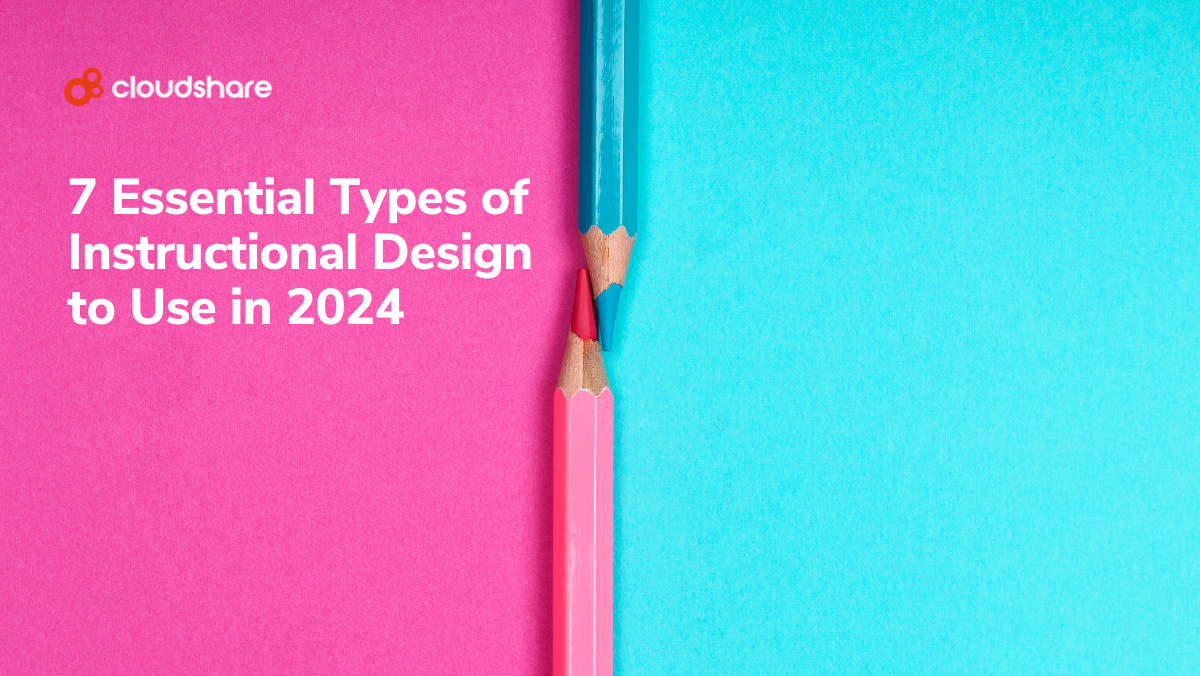
The instructional design process is the foundation of all corporate training, from employee onboarding to customer education. Whether you employ them internally or hire a third party, instructional designers play a crucial role in any training strategy. Their responsibilities typically include:
- Designing and maintaining content within a learning management system.
- Adjusting coursework based on feedback from participants.
- Understanding and applying new corporate training principles and trends.
- Developing learning materials such as tutorial videos, guided walkthroughs, online knowledge bases, etc.
As you’ve probably guessed, instructional design can be a fairly complex field — but the right instructional design model can make it considerably less challenging by providing a structured framework that guides the development of effective training programs. So which model should you choose for your corporate training program?
We’ve summarized a few of the most popular design models below.
Understanding the Different Instructional Design Models (IDS)
An instructional design model is a framework or process that provides a systematic approach to designing and developing more effective instructional materials. It typically guides instructors via a series of steps, from analyzing learner needs and goals to designing, developing, and evaluating materials that meet those needs. By following an instructional design model, learning designers benefit from:
- A structured approach to developing training content.
- A repeatable design process that saves both time and money.
- The peace of mind that comes with knowing they are working with proven research and best practices.
- A framework that can be adapted to a wide range of instructional contexts and subject areas.
- A more effective means of aligning business objectives and learner goals.
There is no right or wrong approach to instructional design. Different models are applicable to different use cases, and what works for one business may not work for another. As you read about each of the models, keep the following questions in mind:
- What is the core objective of your training initiative?
- What kind of content are you attempting to teach your learners?
- How technical are your training materials?
- What delivery modalities do you plan to use? Are you delivering fully virtual training, or a blended approach?
- Who are the key stakeholders in this training initiative, and what do they want to achieve?
Here are a few instructional design models we’ll be covering:
- Bloom’s Taxonomy
- ADDIE
- SAM
- Merrill’s Principles of Instruction
- Dick and Carey
- Morrison, Ross, and Kemp
- ASSURE
Bloom’s Taxonomy
Developed in 1956 by Benjamin Bloom and collaborators Max Englehart, Edward Furst, Walter Hill, and David Krathwohl, Bloom’s Taxonomy is a hierarchical framework that maps the different phases of the learning process to different levels of human cognition. Though it has seen considerable revision over the years, Bloom’s Taxonomy is still widely used in the education sector to this day. The revised taxonomy is as follows:
- Remembering key information and basic concepts.
- Understanding, interpreting and summarizing those concepts.
- Applying and implementing those concepts practically.
- Analyzing, classifying, and differentiating the different concepts and how they fit together.
- Evaluating and critiquing information associated with the training.
- Creating new ideas and concepts based on what one has learned.
Additionally, Bloom’s Taxonomy establishes four distinct types of knowledge — factual, conceptual, procedural, and metacognitive.
This model is great for achieving higher-order learning to enable more complex outcomes, allowing learners to better understand and retain information. However, the model’s top-down approach to learning doesn’t always account for how learning experiences often include several types of learning happening simultaneously.
Bloom’s Taxonomy is a good option for any scenario where you have to develop your training more or less from scratch, as it will help you establish a solid foundation.
ADDIE
Whereas Bloom’s Taxonomy focuses on cognition and the learning process, ADDIE (Analyze, Design, Develop, Implement, and Evaluate) is a model for instructional systems design. It’s intended to help instructional designers create effective tools and materials to support their learning objectives. Though it’s not without its weaknesses, ADDIE is nevertheless incredibly widespread, so much so that it actually serves as a basis for the majority of instructional design models currently on the market.
ADDIE breaks instructional design down into five steps.
- Analysis. Define learning objectives, assess your current learning environment and trainees, determine a timeline for completion, and identify any potential problems that may arise during the design process.
- Design. Establish and document the strategies with which your organization will achieve its learning objectives.
- Development. Create courses and other training materials using the documentation from the Design phase as a guideline.
- Implementation. Ensure the necessary infrastructure is in place to deliver the completed training materials to their target audience then use that infrastructure to facilitate training.
- Evaluation. Examine the effectiveness of your training in achieving your learning objectives and identify potential areas of improvement.
This model is great as it provides a clear and systemized structure for both planning and execution with its five phased approach. However, the model is often criticized for being too rigid with its linear format, which can make it unresponsive to changing needs from stakeholders.
ADDIE tends to be quite flexible and can be applied to everything from developing training tools to an overall training strategy.
SAM
SAM (or the Successive Approximation Model) is a streamlined adaptation of ADDIE, focused on agile, iterative, and collaborative instructional design. SAM is intended to be both simple and repeatable, embracing a recursive design process rather than an iterative one. While there are several variations of SAM, the most straightforward consists of just three phases:
- Preparation includes gathering information and context, identifying your objectives, and brainstorming training materials through collaboration.
- Iterative Design takes the materials developed during the preparation phase and transforms them into a prototype to facilitate quick evaluation and testing.
- Iterative Development implements the finished prototype.
Steps two and three can be repeated as often as necessary.
This model offers enhanced flexibility, allowing for quick changes to training materials, adapting to budgets, or schedules. However, it can also become fairly repetitive and the intensive review process can lead to wasted resources.
SAM is best used when you need to rapidly design and deploy training materials, as its streamlined and iterative approach makes it well-suited for agile design.
Merrill’s Principles of Instruction
Merrill’s Principles of Instruction (MPI) is a set of five pillars devised by M. David Merrill to facilitate more effective task-based learning. MPI is founded on the belief that effective learning goes hand-in-hand with problem-solving. Operating on the idea that learners must actively engage with content in order to fully understand it, the MPI model consists of the following:
- Demonstrate how new skills and knowledge relate to the real world.
- Give learners the opportunity to apply what they’ve learned in a hands-on setting.
- Activate learners by tying your training materials back to their existing knowledge and experience.
- Help learners integrate their newfound expertise into their day-to-day.
- Engage and motivate learners through task-centric, interactive training material.
This model’s biggest benefit is its conciseness, which allows for the creation of impactful learning experiences. However, it does take a design-only focus, meaning it fails to account for how a learner acquires knowledge in the first place.
MPI is an excellent choice for technical skills training due to its focus on hands-on learning.
Dick and Carey
The Dick and Carey Model is intended to guide the development of training content and curricula. Like several other models on this list, Dick and Carey is intended to be at least somewhat repeatable. The model consists of nine interconnected phases:
- Identifying learning goals and objectives.
- Analyzing instructional content to identify required skills and competencies.
- Analyzing learners’ preferences, prior knowledge, and skills.
- Defining what learners should be able to do once their training is complete.
- Developing an assessment model for the training alongside an instructional strategy.
- Creating training materials based on your assessment model and instructional strategy.
- Revising your assessment model, strategy, and courses as frequently as required.
- Evaluating the effectiveness of your training.
- Iteratively revising and optimizing your training based on your evaluation.
This model really shines with its descriptive breakdowns of the overall design and development process with twice as many steps as ADDIE. However, those additional steps may be seen as excessive and repetitive, with a lot of initial legwork required to start using the model at all.
The Dick and Carey Model works best for designers who are heavily focused on content development.
Morrison, Ross, and Kemp
Known colloquially as the Kemp Model, this approach to instructional design envisions both the design and the learning process as circular. Built on the idea that continuous improvement is necessary for an effective training initiative, the Kemp Model’s core elements are interdependent and nonlinear.
This means that instructional designers can begin the design process at any of the following points:
- Identifying specific learning objectives or problems.
- Understanding the characteristics, learning styles, and needs of trainees.
- Brainstorming the overall content of the course.
- Defining your ideal learning outcomes.
- Developing and structuring learning content.
- Devising strategies that allow each participant to master their training and achieve the desired outcome.
- Planning out how the training material will be delivered to learners.
- Creating a learner assessment and evaluation process.
- Finding the right tools and resources to support both learners and instructors.
This model really excels when it comes to enabling flexible digital learning as it takes a holistic approach that caters to a wide variety of learning styles and subjects. However, its lack of a step-by-step process may seem unstructured to some people and it tends to be more resource-intensive compared to other models.
The Kemp Model goes well with microlearning-focused initiatives.
ASSURE
A modified instructional design model originally meant to be used in the classroom, ASSURE blends characteristics of multiple instructional design models and principles. This model positions the learner front and center, establishing them as the foundation of the model rather than the content or learning objective. The established process for the ASSURE Model is as follows:
- Analyze learners, including their goals, learning styles, preferences, and needs.
- State your organization’s learning standards and key objectives.
- Select strategies, technologies, materials, and media to support your learners.
- Use the components you gathered to develop a training program.
- Require engagement and participation from your learners — and identify the best ways to achieve that engagement.
- Evaluate and revise your training.
This model is a learner-centric model that really listens to learners, provides guidance for writing objectives, and seamlessly integrates technology into planning and delivery. However, the model tends to be overly academic and creating effective lessons can be time-consuming.
The ASSURE Model works well in hybrid or blended learning environments.
It’s Time to Start Designing Smarter Training
We’ve shared the seven most common training models above as a starting point. Still looking to learn more about how to create smarter training programs?
Here are five of the most effective elements you can incorporate into your training environments right away.





